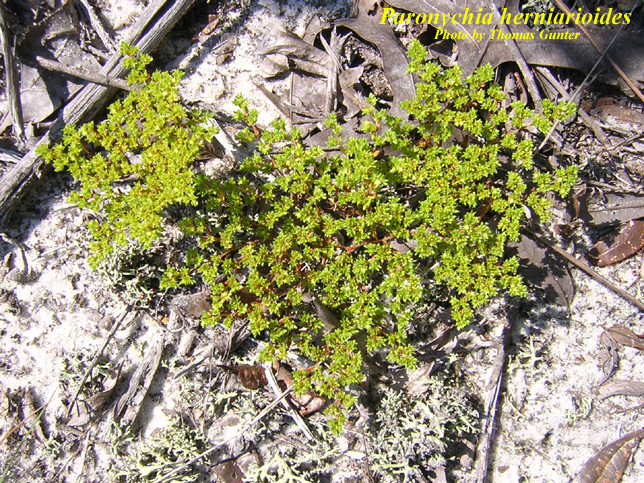Difference between revisions of "Paronychia herniarioides"
(→Conservation and Management) |
Krobertson (talk | contribs) |
||
| Line 22: | Line 22: | ||
Synonym: ''Gastronychia herniarioides'' (Michx.) Small | Synonym: ''Gastronychia herniarioides'' (Michx.) Small | ||
| − | ''Paronychia'' comes from a Greek word for whitlow, a disease that infected the fingers ( | + | ''Paronychia'' comes from a Greek word for whitlow, a disease that infected the fingers. <ref name="Core 1941">Core, E. L. (1941). "The North American Species of Paronychia." The American Midland Naturalist 26(2): 369-397</ref> |
==Description== | ==Description== | ||
| Line 33: | Line 33: | ||
==Ecology== | ==Ecology== | ||
===Habitat=== <!--Natural communities, human disturbed habitats, topography, hydrology, soils, light, fire regime requirements for removal of competition, etc.--> | ===Habitat=== <!--Natural communities, human disturbed habitats, topography, hydrology, soils, light, fire regime requirements for removal of competition, etc.--> | ||
| − | In the Coastal Plain, ''P. herniarioides'' occurs in xeric, sandy soil of longleaf pine-turkey oak sand ridges. Associated species include ''Lyonia ferruginea, Ceratiola, Stylisma pickeringii var. pickeringii, Opuntia humifusa, Quercus geminata, Quercus myrtifolia'' and ''Polygonella'' | + | In the Coastal Plain, ''P. herniarioides'' occurs in xeric, sandy soil of longleaf pine-turkey oak sand ridges. Associated species include ''Lyonia ferruginea, Ceratiola, Stylisma pickeringii var. pickeringii, Opuntia humifusa, Quercus geminata, Quercus myrtifolia'' and ''Polygonella.'' <ref name="FSU Herbarium">Florida State University Robert K. Godfrey Herbarium database. URL: [http://herbarium.bio.fsu.edu http://herbarium.bio.fsu.edu]. Last accessed: October 2015. Collectors: Oscar E. Baynard, Morton Bortell, L.J. Brass, R.A. Davidson, Robert K. Godfrey, D.W. Hall, R. Kral, A.M. Laessle, N.E. Lee, R.A. Norris, Kent D. Perkins, A.E. Radford, Grady W. Reinert, G.L. Webster, R.L. Wilbur, R.F. Thorne. States and Counties: Florida: Clay, Gilchrist, Highlands, Lake. Georgia: Ben Hill, Coffee, Dougherty, Emanuel, Marion, Mitchell, Wheeler. South Carolina: Lee. Compiled by Tall Timbers Research Station and Land Conservancy.</ref> <ref name="Schotz 2009">Schotz, A. (2009). "Noteworthy Collection: Alabama." Castanea 74(2): 185-188.</ref> |
<!--===Phenology===--> <!--Timing off flowering, fruiting, seed dispersal, and environmental triggers. Cite PanFlora website if appropriate: http://www.gilnelson.com/PanFlora/ --> | <!--===Phenology===--> <!--Timing off flowering, fruiting, seed dispersal, and environmental triggers. Cite PanFlora website if appropriate: http://www.gilnelson.com/PanFlora/ --> | ||
| Line 40: | Line 40: | ||
<!--===Fire ecology===--> <!--Fire tolerance, fire dependence, adaptive fire responses--> | <!--===Fire ecology===--> <!--Fire tolerance, fire dependence, adaptive fire responses--> | ||
===Pollination=== | ===Pollination=== | ||
| − | The following Hymenoptera families and species were observed visiting flowers of ''Paronychia herniarioides'' at Archbold Biological Station | + | The following Hymenoptera families and species were observed visiting flowers of ''Paronychia herniarioides'' at Archbold Biological Station: <ref name="Deyrup 2015">Deyrup, M.A. and N.D. 2015. Database of observations of Hymenoptera visitations to flowers of plants on Archbold Biological Station, Florida, USA.</ref> |
Halictidae: ''Lasioglossum nymphalis'' | Halictidae: ''Lasioglossum nymphalis'' | ||
| Line 56: | Line 56: | ||
==References and notes== | ==References and notes== | ||
| − | |||
| − | |||
| − | |||
| − | |||
| − | |||
| − | |||
| − | |||
Revision as of 16:11, 3 August 2016
| Paronychia herniarioides | |
|---|---|

| |
| Photo by Thomas Gunter, Atlas of Florida Vascular Plants | |
| Scientific classification | |
| Kingdom: | Plantae |
| Division: | Magnoliophyta - Flowering plants |
| Class: | Magnoliopsida – Dicotyledons |
| Order: | Caryophyllales |
| Family: | Caryophyllaceae |
| Genus: | Paronychia |
| Species: | P. herniarioides |
| Binomial name | |
| Paronychia herniarioides (Michx.) Nutt. | |

| |
| Natural range of Paronychia herniarioides from USDA NRCS Plants Database. | |
Common name: coastal plain nailwort
Contents
Taxonomic notes
Synonym: Gastronychia herniarioides (Michx.) Small
Paronychia comes from a Greek word for whitlow, a disease that infected the fingers. [1]
Description
A description of Paronychia herniarioides is provided in The Flora of North America.
Distribution
The distribution of P. herniarioides is restricted to the southeastern Coastal Plain from South Carolina south to Florida and west to Alabama. It is rare in South Carolina and Florida[2].
Ecology
Habitat
In the Coastal Plain, P. herniarioides occurs in xeric, sandy soil of longleaf pine-turkey oak sand ridges. Associated species include Lyonia ferruginea, Ceratiola, Stylisma pickeringii var. pickeringii, Opuntia humifusa, Quercus geminata, Quercus myrtifolia and Polygonella. [3] [4]
Pollination
The following Hymenoptera families and species were observed visiting flowers of Paronychia herniarioides at Archbold Biological Station: [5]
Halictidae: Lasioglossum nymphalis
Sphecidae: Tachysphex apicalis
Conservation and management
Cultivation and restoration
Photo Gallery
References and notes
- ↑ Core, E. L. (1941). "The North American Species of Paronychia." The American Midland Naturalist 26(2): 369-397
- ↑ [[1]] NatureServe Accessed: February 19, 2016
- ↑ Florida State University Robert K. Godfrey Herbarium database. URL: http://herbarium.bio.fsu.edu. Last accessed: October 2015. Collectors: Oscar E. Baynard, Morton Bortell, L.J. Brass, R.A. Davidson, Robert K. Godfrey, D.W. Hall, R. Kral, A.M. Laessle, N.E. Lee, R.A. Norris, Kent D. Perkins, A.E. Radford, Grady W. Reinert, G.L. Webster, R.L. Wilbur, R.F. Thorne. States and Counties: Florida: Clay, Gilchrist, Highlands, Lake. Georgia: Ben Hill, Coffee, Dougherty, Emanuel, Marion, Mitchell, Wheeler. South Carolina: Lee. Compiled by Tall Timbers Research Station and Land Conservancy.
- ↑ Schotz, A. (2009). "Noteworthy Collection: Alabama." Castanea 74(2): 185-188.
- ↑ Deyrup, M.A. and N.D. 2015. Database of observations of Hymenoptera visitations to flowers of plants on Archbold Biological Station, Florida, USA.